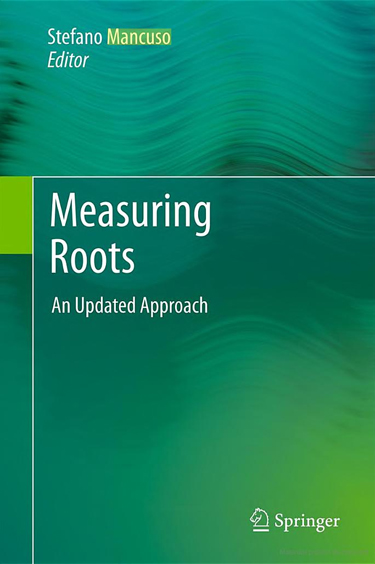Edited Books
Measuring Roots – An Updated Approach
S. Mancuso, University of Florence, Sesto Fiorentino, Italy (Ed.)
Roots represent half of the plant body – and arguably the more interesting half. Despite its obvious importance for the whole plant, until recently our knowledge of the root apparatus was very limited, mostly due to the inadequacy of the techniques available. Recent advances in the visualization and measurement of roots have resulted in significant progress in our understanding of root architecture, growth and behaviour. In this book international experts highlight the most advanced techniques, both lab and field methods, and discuss them in detail. Measuring Roots combines academic and practical aspects of this topic, making it a universal handbook for all researchers and others interested in root-measuring methods.
1 Higher Plants: Structural Diversity of Roots
2 Electrical Impedance Spectroscopy and Roots
3 Multi Electrode Arrays (MEAs) and the Electrical Network of the Roots
4 The Vibrating Probe Technique in the Study of Root Physiology Under Stress
5 The Use of Planar Optodes in Root Studies for Quantitative Imaging Stephan Blossfeld and Dirk Gansert
6 Applications of Confocal Microscopy in the Study of Root Apparatus
7 High-Throughput Quantification of Root Growth
8 Flat Optical Scanner Method and Root Dynamics
9 3D Quantification of Plant Root Architecture In Situ
Part II Field Methods
10 Geophysical Imaging Techniques
11 Multi-electrode Resistivity Imaging
12 Using Ground-Penetrating Radar to Detect Tree Roots and Estimate Biomass
13 Root Structure: In Situ Studies Through Sap Flow Research
14 Root Function: In Situ Studies Through Sap Flow Research
15 Fine Root Dynamics and Root Respiration
16 Biases and Errors Associated with Different Root Production Methods and Their Effects on Field Estimates of Belowground Net Primary Production
17 Minirhizotrons in Modern Root Studies
18 Fine Root Turnover
Waterlogging Signalling and Tolerance in Plants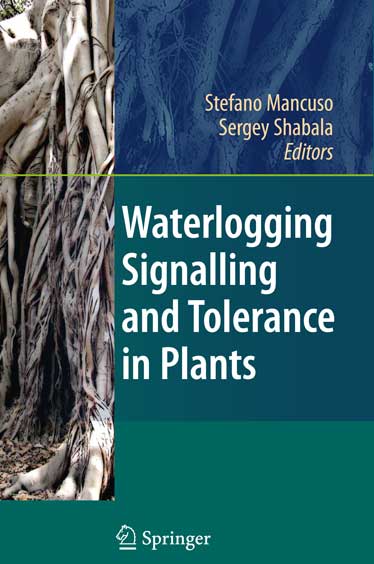
Stefano Mancuso, University of Florence, Italy
Sergey Shabala, University of Tasmania, Hobart, TAS, Australia
Waterlogging is a major problem for plant cultivation in many regions of the world.
This book combines both academic and practical aspects of this topic. Based on recent progress in cell and molecular biology, various facets of waterlogging signaling and tolerance are addressed, starting from the molecular level, through membrane transport, cells and plant organs, up to the whole organism. Leading scientists contribute 13 chapters grouped into the following main parts:
· Whole-Plant Regulation
· Intracellular Signaling
· Membrane Transporters in Waterlogging Tolerance
· Agronomical and Environmental Aspects
This work offers a universal handbook for any researcher or agronomist interested in the impact of waterlogging in plants.
1. Oxygen Transport in Waterlogged Plants
2. Waterlogging and Plant Nutrient Uptake
3. Strategies for Adaptation to Waterlogging and Hypoxia in Nitrogen Fixing Nodules of Legumes
4. Oxygen transport in the sapwood of trees
5. pH Signaling During Anoxia
6. Programmed Cell Death and Aerenchyma Formation under Hypoxia
7. Oxygen Deprivation, Metabolic Adaptations and Oxidative stress
8. Root Water Transport under Waterlogged Conditions and the Roles of Aquaporins in Transport of Water and Other Molecules Relevant to Oxygen Deficient Conditions
9. Root Oxygen Deprivation and Leaf Biochemistry in Trees
10. Ion Transport in Aquatic Plants
11. Genetic Variability and Determinism of Adaptation of Plants to Soil Waterlogging
12. Improvement of plant waterlogging tolerance
Signaling in plants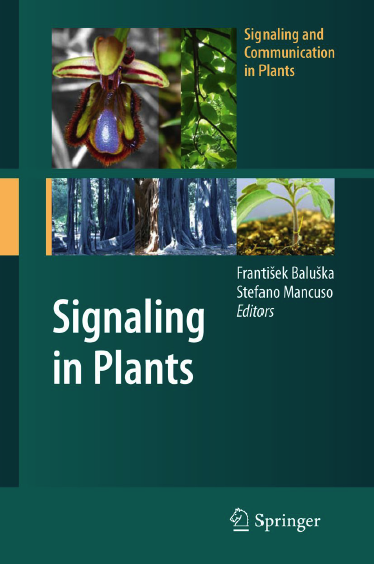
František Baluška, University of Bonn, Germany
Stefano Mancuso, University of Florence, Italy
This book addresses diverse aspects of signaling at all levels of plant organization, starting from single molecules; through vesicle recycling and organelles, dynamic actin cytoskeletons, and plant organs bending in response to sensory stimuli induced by abiotic cues such as gravity and light; up to the whole organism as related to its circadian clock or pathogen defense. Emphasis is placed on the integrative aspects of signaling, which foster our understanding of sensory and communicative plants in all their complexity.
Peter Nick – Auxin and the Communication Between Plant Cells
Narendra Tuteja – Integrated Calcium Signaling in Plants
Miroslav Ovečka and Irene K. Lichtscheidl – MAPK Signaling
Sibylle Hirsch and Giles Oldroyd – Integrated Nod Factor Signaling in Plants
Tal Sherman and Hillel Fromm – Physiological Roles of Cyclic Nucleotide Gated Channels in Plants
V. Žárský and M. Potocký – Signaling in Vesicle Traffic: Protein-Lipid Interface in Regulation of Plant Endomembrane Dynamics
Alison Sinclair, Mike Schenkel, and Jaideep Mathur – Signaling to the Actin Cytoskeleton During Cell Morphogenesis and Patterning
Claude Penel and Christophe Dunand – Signaling via Plant Peroxidases
Ewelina Rodakowska, Marta Derba-Maceluch, Anna Kasprowicz, Paweł Zawadzki, Agnieszka Szuba, Daniel Kierzkowski, and Przemysław Wojtaszek – Signaling and Cell Walls
Chalivendra C. Subbaiah – Ionic Loops and Rebounds: Oxygen-Deprivation Signaling in Plants
Patrick H. Masson, John Stanga, Carolyn Neal, Laura Vaughn, Katherine Baldwin, and Gengxiang Jia – Signaling in Plant Gravitropism
R. Brandon Celaya, Ullas V. Pedmale, and Emmanuel Liscum – Signaling in Phototropism
Eleni Boikoglou and Seth J. Davis – Signaling in the Circadian Clock
Hans Thordal-Christensen – Vesicle Trafficking in Plant Pathogen Defence
Communication in Plants – Neuronal Aspects of Plant Life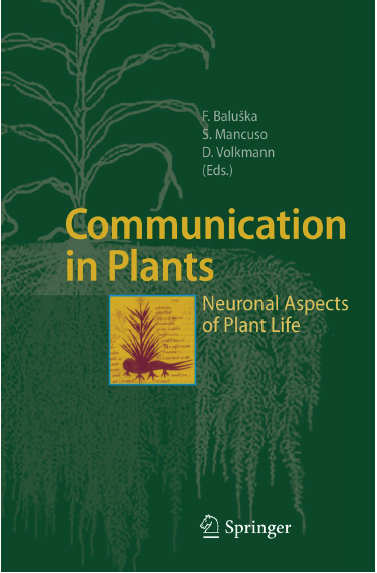
František Baluška, University of Bonn, Germany
Stefano Mancuso, University of Florence, Italy
Dieter Volkmann, University of Bonn, Germany
Plant neurobiology is a newly emerging field of plant sciences. It covers signalling and communication at all levels of biological organization – from molecules up to ecological communities. In this book, plants are presented as intelligent and social organisms with complex forms of communication and information processing.
Authors from diverse backgrounds such as molecular and cellular biology, electrophysiology, as well as ecology treat the most important aspects of plant communication, including the plant immune system, abilities of plants to recognize self, signal transduction, receptors, plant neurotransmitters and plant neurophysiology. Further, plants are able to recognize the identity of herbivores and organize the defence responses accordingly. The similarities in animal and plant neuronal/immune systems are discussed too. All these hidden aspects of plant life and behaviour will stimulate further intense investigations in order to understand the communicative plants in their whole complexity.
– Introduction and Perspectives
– Tony Trewavas: The green plant as an intelligent organism
– František Baluška, Andrej Hlavacka, Stefano Mancuso, Dieter Volkmann, Peter W. Barlow: Neurobiological view of plants and their body plan
– Peter W. Barlow: Charles Darwin and the plant root apex: closing the gap in plant living systems theory
– Tsvi Sachs: How can plants choose the most promising organs?
– Peter M. Neumann: The role of root apices in shoot growth regulation
– Noni (V.E.) Franklin-Tong, S.G. Thomas: Signals and targets triggered by self-incompatibility in plants
– Thorsten Nürnberger, Birgit Kemmerling: Signal perception and transduction in plant innate immunity
– Matteo De Stefano, Alberto Ferrarini, Massimo Delledonne: Nitric oxide involvement in incompatible plant-pathogen interactions
– María Luciana Lanteri, Magdalena Graziano, Natalia Correa-Aragunde, Lorenzo Lamattina: From cell division to organ shape: nitric oxide is involved in auxin-mediated root development
– Susan Murch: Neurotransmitters, neuroregulators and neurotoxins in plants
– Tobias Mueller, Wolfgang Koch, Daniel Wipf: Amino acid transport in plants and transport of neurotransmitter in animals, a common mechanism?
– Aaron Fait, Ayelet Yellin, Hillel Fromm: GABA and GHB neurotransmitters in plants and animals
– Matthew Gilliham, Malcolm Campbell, Dirk Becker, Christian Dubos, Romola Davenport: The Arabidopsis thaliana glutamate-like receptor family (AtGLR)
– Elison B. Blancaflor, Kent D. Chapman: Similarities between endocannabinoid signaling in animal systems and N -Acylethanolamine (NAE) metabolism in plants
– Stanley Roux, Charlotte Song and Collene Jeter: Regulation of plant growth and development by extracellular nucleotides
– Vadim Demidchik: Regulation and physiological implications of plant nonselective cation channels
– Elizabeth McCormack, Luis Velasquez, Nikki A. Delk, Janet Braam: Touch-responsive gene expression
– Sergey Shabala: Oscillations in plants
– Kazimierz Trebacz, Halina Dziubinska, Elzbieta Krol: Electrical signals in long-distance communication in plants
– Rainer Stahlberg, Robert E Cleland, Elizabeth Van Volkenburgh: Slow wave potentials – a propagating electrical signal unique to higher plants
– Eric Davies, Bratislav Stankovic: Electrical signals, the cytoskeleton, and gene expression: a hypothesis on the coherence of the cellular responses to environmental insult
– Jörg Fromm, Silke Lautner: Characteristics and functions of phloem-transmitted electrical signals in higher plants
– Stefano Mancuso, Sergio Mugnai: Long-distance signal transmission in trees
– Alexander G. Volkov: Electrophysiology and phototropism
– Edgar Wagner, Lars Lehner, Johannes Normann, Justyna Veit, Jolana Albrechtova: Hydro-electrochemical integration of the higher plant – basis for electrogenic flower initiation
– Jeremy Rhodes, John Thain, David Wildon: Signals and signalling pathways in plant wound responses
– Laura G. Perry, Tiffany L. Weir, Balakrishnan Prithiviraj, Mark W. Paschke, Jorge M. Vivanco: Root exudation and rhizosphere biology: multiple functions of a plant secondary metabolite
– Velemir Ninkovic, Robert Glinwood, Jan Pettersson: Communication between undamaged plants by volatiles: the role of allelobiosis
Rhythms in Plants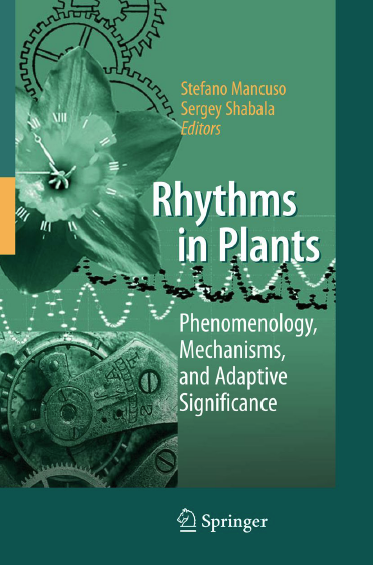
Phenomenology, Mechanisms, and Adaptive Significance
Stefano Mancuso, University of Florence, Italy
Sergey Shabala, University of Tasmania, Hobart, TAS, Australia
Rhythmic behaviour is quintessential to life itself. Advances in plant molecular biology, micro/nanotechnology and applied mathematics provide new tools for understanding how environmental signals and internal clocks regulate rhythmic gene expression and development, and how these signals are translated into physiological responses at various levels of structural organisation. This book reviews recent progress in assessing underlying mechanisms controlling plant circadian and ultradian oscillations, and their physiological implications for growth, development, and adaptive responses to the environment. It focuses on mechanisms and theoretical concepts at the level of the cell to the entire plant. Written by a diverse group of leading researchers, it will surely spark the interest of readers from many branches of science: from physicists and chemists wishing to learn about multi-faceted rhythms in plant biology, to biologists dealing with state-of-the-art modelling of such rhythmic phenomena.
– Rhythmic leaf movements
– The pollen tube oscillator: integrating biophysics and biochemistry into cellular growth and morphogenesis
– Ultradian growth oscillations in organs: physiological signal or noise?- Nutations in plants
– Oscillations in transpiration
– Oscillations and signal processing in guard cells
– Calcium oscillations in guard cell adaptive responses to environment
– Circadian rhythms in stomata: physiological and molecular aspects
– How plants identify the season by using a circadian clock
– Rhythmic stem extension growth and leaf movements as markers of plant behaviour: the integral output from endogenous and environmental signals
– Oscillations and plant morphogenesis
– Molecular aspects of the Arabidopsis circadian clock
– Rhythms, clocks and deterministic chaos in unicellular organisms
– Modelling Ca2+ oscillations in plants
– Noise-induced phenomena and complex rhythms: theoretical considerations, modelling and experimental evidence

